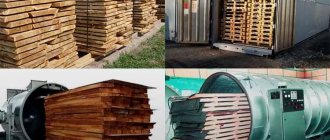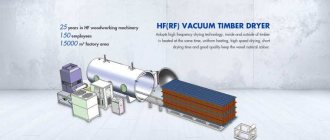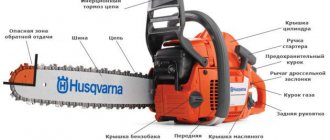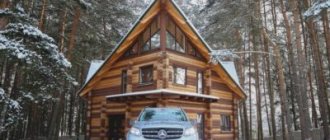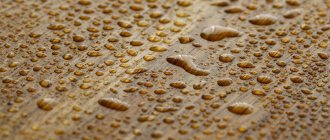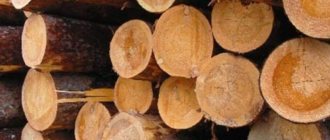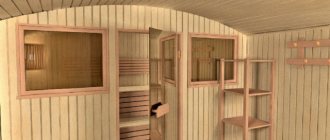Heat supply to the drying process (hereinafter we are talking about convective drying chambers) has, like any other process, its own characteristics. In addition, one of the most rational methods is the use of boilers operating on wood waste, which also have their own characteristics.
Dryers require a coolant supply with stable temperature parameters throughout the drying cycle; this is perhaps the only significant heat supply requirement of a dryer. The nature of heat consumption is quite complex. Immediately after loading the raw materials into the dryer, maximum heat is removed; energy is spent on heating (in winter - freezing/heating) the raw materials to the temperature of the drying process. In this mode, the boiler, with a thermal power equal to the maximum heat removal power of the dryer, will operate continuously at rated power, which is the best mode for boiler equipment. As it warms up, heat consumption decreases, and the boiler automation system should reduce the boiler power accordingly. After warming up, heat is consumed only to maintain the temperature, heat the incoming air and evaporate moisture. Moreover, the closer to the end of the cycle, the lower the heat consumption. (Heat consumption depends on many factors, a typical case is considered here.) Heat consumption also has a pulsed nature - for example, heat extraction with maximum power for 5 minutes then a pause for 15 minutes. Therefore, the boiler must have high power maneuverability and low inertia. If this is not a problem for a gas boiler or a diesel burner, then for a solid fuel boiler it is not so simple. The fact is that it does not take much time to ignite a gas or liquid fuel burner; solid fuel, including wood, does not burn so quickly, and wood also requires a well-heated firebox (high-moisture fuel does not burn well in a “cold” firebox). fuel and emissions into the atmosphere increase with a decrease in efficiency, regardless of the combustion method). When the heat consumption of the dryer stops (the set temperature in the chamber has been reached), the remaining fuel in the furnace of the solid fuel boiler, burning, continues to increase the temperature of the coolant. Thus, to compensate for inertia, a wood waste boiler must have a heat accumulator, usually in the form of a large volume of coolant. For example, the coolant volume of a boiler KWm(a) is 0.82 with automatic supply of bulk fuel is about 2.5 m 3, which is more than enough for stable operation.
If there is more than one chamber, the heat consumption is equalized. The maximum boiler power for the 1st chamber and 2 chambers may not differ very significantly. As a rule, when 2 or more chambers are operating, the moments of maximum heat consumption of the chambers do not coincide (the chambers are not loaded at the same time) and the boiler power can be equal to: the maximum heat consumption of one chamber plus the heat consumption in the middle of the drying cycle.
Sometimes several heterogeneous loads are pumped to one boiler room (boiler), for example, heating production areas and one or two chambers. In this case, new pitfalls appear. The drying chamber requires a fairly hot coolant (75-95 ° C) with a constant temperature; moreover, the average heat consumption depends little on the time of year. Heating requires adjustment of the coolant temperature depending on fairly strong fluctuations in weather conditions and is not required (heating) at all in the summer. No boiler can simultaneously satisfy the requirements of drying chambers and heating when connected in parallel. Coordination of such dissimilar loads is possible using various schemes, considerable experience in the use of which has been accumulated at Kotloservis LLC.
Another important point that is worth thinking about, if you want to supply both drying chambers and heating with heat from one boiler room, is that the average heat consumption in summer and winter will in some cases be very different. The obstacle here will be that boilers using wood waste (of any type and design, including “gas generators”, which is due to the peculiarities of wood combustion) do not operate stably at 10-30% of the rated power. Such a large boiler, which will work normally in winter, can cause many problems in summer, especially at the last stage of the drying process.
Choosing the right boiler and the essence of drying itself
The wood drying boiler is designed by specialists in the field to remove moisture from the wood itself using a boiler equipped with ventilation, humidification and heating. Chamber drying can be gas (using gas) and steam (using steam).
Heat is supplied by forced means, i.e. by ventilation.
Each tree species needs a specific drying chamber, which is suitable specifically for a particular wood:
- For all types of coniferous species, these are boilers designed in accordance with GOST 19773-84.
- For all types of hardwood - this is GOST 18867-84.
The technological process is approximately this: boards of the same size are stacked evenly on top of each other on a cart that is used to transport wood and delivered to the drying chamber. This installation is placed in a gaseous room, drying the material to the required humidity, selecting the appropriate drying mode: soft, normal, forced, high temperature. All modes comply with GOST.
Drying is selected based on the thickness of the wood, species and where the material will be used. The drying chamber is divided into 3 air supply options. The temperature in the boiler cannot be changed abruptly, it can only be done by gradually lowering the temperature: for example, if the wood moisture content is 30%, then we first dry it at stage 1, and then move on to stage 2 drying. If the moisture content of the material is 20%, then we first dry it at 2 stages, only then move on to the 3rd stage of drying.
Wood drying chamber
Types of drying chambers
A dryer is a complex industrial piece of equipment. It implements the selected processing method. Modern manufacturers offer the following types of drying chambers:
- convective;
- with IR emitters;
- vacuum;
- aerodynamic;
- dryers operating in the microwave range.
The first type is based on creating a hot air flow using powerful heating elements (heaters). The products are stacked to create hot air circulation along the surface of each layer.
Infrared systems use emitters that are directed at the surface being treated.
In vacuum units, the required temperature is created using electric or hydrodynamic heaters. They are located along the side walls or laid between layers. Using a pump, air is pumped out and a vacuum is created inside.
In aerodynamic devices, the technological process occurs due to the creation of forced circulation of hot air along the stacked stacks.
Microwave devices use special heating elements that heat the wood to its entire thickness. Moisture is removed using an organized ventilation system.
Convector dryers
In chambers of this type, air, steam or flue gas heated to a high temperature are used to remove excess moisture. Forced convection moves the stacked lumber above the surface. The heating temperature of the flowing stream reaches two hundred degrees Celsius. This technique allows you to reduce humidity to 14%.
Structurally, it is a metal box in the shape of a rectangular parallelepiped. The walls contain: heating system, fans, outlet (exhaust) valves. The most common options are systems designed to process 20 cubic meters of wood with natural moisture. These lumber drying kilns are capable of processing any type of wood.
Vacuum dryer
Such systems are used for processing valuable timber. They create heating of the air flow followed by vacuum removal of excess moisture. Thanks to the creation of a reduced pressure inside, close to a vacuum of 0.09 MPa, the temperature of evaporation of water from wood is reduced to approximately 45.5 degrees Celsius. This technological process proceeds on the basis of the known physical laws of hydrodynamics. Reducing the heating temperature allows you to reduce the required energy costs.
Vacuum drying equipment eliminates the creation of internal high voltage in the upper layers of lumber. Using this method allows you to obtain humidity indicators from four to six percent. The main disadvantages of this method include:
- low one-time load (no more than 8 cubic meters);
- high energy consumption;
- technological difficulties in creating a vacuum chamber;
- high final cost.
Aerodynamic dryer
This is the most common and cheapest drying system. The operating principle of the drying chamber is based on the use of energy created by the aerodynamic movement of warm air under the influence of a fan.
When the air inside is compressed, the pressure increases. Consequently, the temperature rises. Contact with the external environment occurs only after the completion of the processing cycle. This method allows you to dry lumber to a moisture level of 8%.
Microwave drying
Evaporation occurs due to heating of water in the inner layers of wood under the influence of microwave radiation. It is produced by high-frequency devices (usually a magnetron is used). Irradiation leads to an increase in the frequency of the vibrational process of water molecules, which causes an increase in temperature and subsequent evaporation. The excess moisture created at the surface of the lumber is removed by a flow of air pumped by special fans.
Drying chambers for lumber with microwave generators are used quite rarely. This is due to the high cost of the generators themselves and high energy costs.
The advantages of such a boiler
This drying is the most effective and suitable option. He has the following qualities:
- it does not depend in any way on weather conditions;
- a small amount of defects;
- all work is automated;
- convenient and simple program management;
- ultimately we obtain wood with the required moisture content;
- maintains uniform drying and shape.
Such drying boilers can solve several problems at once and, according to their characteristics, are the most economical equipment for drying wood.
Hello dear readers and subscribers of Andrey Noak's Blog! Today we will look at how a wood-fired lumber dryer works. Let's find out how to make it and consider whether it is profitable to heat with wood? Of course, we will consider small drying chambers that are suitable for small production or at home.
Let me start by saying that I came across this technology when I was working at a large woodworking enterprise, which one? And you look at my biography and find out! There were several dryers there, some made of brick, others made of sandwich panels. This furnace was paired with a sawdust vortex and, in addition to the drying chambers, also heated the sawmill and molding production shops. Then I came across drying chambers heated with regular coal.
DIY wood dryer: drawings
Drying is a mandatory stage in preparing wood before processing. To prevent logs from becoming deformed, they are dried under certain conditions, which are created in drying chambers. For your home workshop, you can make a wood dryer with your own hands.
The importance of drying
compact drying chamber
Since ancient times, wood that was cut down several years ago was used to make wood products. Furniture made from damp or improperly dried boards will warp or dry out and crack.
When drying, the material shrinks, raw wooden beams will begin to move over time, and cracks the width of a palm will appear in the walls of the log house. Mold grows in damp wood.
But overdried boards are also bad - the material begins to absorb moisture and swells.
Drying is carried out with hot air or steam, the process is long and expensive, but it gives the wood additional strength, prevents changes in shape and size, and the lumber is stored longer.
Drying modes
There are several modes of drying lumber. In self-made chambers, the temperature increases in stages, removing moisture from the raw materials. Drying technology is selected taking into account:
- wood species;
- dimensions of lumber;
- final and starting humidity;
- dryer features;
- raw material quality categories.
The drying process can be high temperature or low temperature. In the second case, primary processing is carried out at a temperature not reaching 100 degrees.
Low temperature regimes are divided into categories:
- soft - during the drying process, lumber retains all its properties, strength and color do not change;
- normal - color changes slightly, strength decreases slightly;
- forced - when chipping and splitting, brittleness is possible, the color darkens.
The change in ambient temperature at low temperature occurs in three stages. The transition to the next stage is possible when the wood reaches the specified moisture content.
High-temperature treatment is carried out in two stages. The second stage occurs when the moisture content of the raw material decreases to 20%. This technology is used when preparing wood for the construction of secondary structures, allowing for color changes and a decrease in strength.
Types of drying chambers
Drying of wood on an industrial scale is carried out in special chambers. Moisture is removed from the lumber by heated air and carried outside. The device carries out a full wood drying cycle. The room can be:
- prefabricated metal;
- constructed from building materials.
The latter are installed directly in carpentry shops or as free-standing buildings. The walls are made of reinforced concrete or brick.
At large enterprises, several cameras are installed, combined into a module with a common control system and communications connections. Air circulates in the dryer horizontally or vertically-transversely.
Wood can be transported to industrial dryers on rails on carts or laid out using forklifts.
Heat sources in the dryer:
- hot steam;
- smoke;
- radiant heat from special devices;
- heated shelves;
- electric current that passes well through wet logs;
- high frequency electromagnetic field.
The camera is equipped with basic and additional equipment. The main consists of systems:
- supply and exhaust ventilation;
- heat supply;
- hydration.
Additional equipment includes insulation of walls and doors, trolleys for laying material, psychometric equipment, and electric drive.
Industrial dryers are controlled automatically, small homemade dryers are controlled manually. Humidity is regulated by supply and exhaust ventilation and humidifiers. To measure the humidity in a room, a moisture meter is installed that collects data simultaneously in several places.
The following energy sources can be used to heat air: electricity, wood processing waste, liquid and solid fuel.
Types of dryers
According to the method of air movement, chambers are divided into:
- with natural;
- with forced air exchange.
Chambers with natural air exchange are low-performing and the process in them cannot be controlled. Therefore, they are used less and less.
According to the principle of action, the following are distinguished:
- convective;
- condensation dryers.
Convection dryer Condensation dryer
In convection chambers, the wood is blown with streams of hot air, and heat is transferred by convection. They can be deep tunnel or chamber. Logs are loaded into tunnel chambers from one end and unloaded from the other, moving through the chamber, the material is gradually dried.
The cycle duration ranges from 4 to 12 hours. Such cameras are installed in large sawmills. Chamber dryers are more compact; a single microclimate is maintained throughout the entire volume. Allows you to prepare any type of wood to the required condition.
Therefore, most industrial dryers are chamber type.
Using condensation drying technology, moisture released from the material is deposited on coolers, accumulates in containers and is drained outside. The efficiency of such a device is very high, but the process is long and accompanied by high heat losses. The technology is good for preparing hard lumber in small batches. The price of equipment and the cost of condensation drying are lower than convective drying.
Setting up a homemade dryer
solar wood drying chamber
In order to make a dryer with your own hands, you can do without drawings. It is necessary to provide:
- camera room;
- insulation;
- heat source;
- fan.
The area of a dryer built by yourself usually does not exceed 9 square meters. meters. In a square-shaped room it is easier to ensure optimal movement of warm air.
It is desirable that one wall of the chamber be made of concrete slabs, the others made of wood. All walls are insulated from the inside in two layers: polystyrene foam and foil board. An excellent and free insulation material is wood shavings.
And the foil can be replaced with penofol, which perfectly reflects heat.
You can build a separate drying room with your own hands from aluminum; such a structure will last a long time. The frame is made of profile, it is sheathed with sheet metal, which is insulated from the outside. The thickness of the insulation is at least 15 cm. The floor is covered with roofing felt, and a thick layer of shavings is poured on top as thermal insulation.
Care must be taken to thoroughly seal the front door!
The heat emitter can be made in the form of pipes or heating radiators. The water temperature should be 65-95 degrees. It is heated by an electric boiler, wood stove, or gas boiler. For a small chamber, even a two-burner electric stove is sufficient.
If the stove is located directly in the room, you need to line it with bricks. The brick will accumulate heat and gradually radiate it into the dryer.
It’s easy to equip a convection chamber with your own hands by installing a fan heater as a heat source.
When setting up a dryer for your home woodworking workshop with your own hands, it is important to follow fire safety measures. There should always be a fire extinguisher near the building.
Constant circulation of warm water, which is provided by the pump, is important. To ensure that heat is evenly distributed throughout the room, a fan is installed. The workroom is equipped with a wet and dry thermometer.
To make it easier to load the board into the chamber, you can use a trolley on rails. And to increase the usable area, shelving is built on the walls.
The step-by-step instructions are as follows:
- We are building the foundation.
- We are building the frame.
- We cover the frame with sheets of metal.
- Installation of thermal insulation.
- Cover the floor with film and sawdust.
- Installation of supports from bars.
- Installation of heaters and fans.
The design of a homemade chamber for drying lumber in the video:
Example drawings
Advantages of using firewood in drying lumber
- Autonomy. This technology is often used where there are no other alternative technologies for generating heat. This is one of the main advantages.
- Simplicity of technology, install a drying chamber, cook or buy a large water boiler - oops and you're done;
- Cheap heating equipment;
- Easily accessible heating materials;
- Possibility of recycling wood waste (slabs, bins, trimmings);
- There is no need for lengthy starts and stops of equipment;
- Ease of use - maintaining such a stove is quite simple, and cleaning it does not take much time.
Flaws
- The disadvantages I would include is the impossibility of automating the process, so you need to constantly monitor the process and maintain the temperature;
- The next point comes from the previous point - the impossibility of one person monitoring several boilers. This is due to the fact that chocks need to be constantly thrown and cooked;
- The need for additional preparation of fuel, the logs must be sawed, and sometimes even split;
- There must be a person next to the boiler constantly, day and night, who would add firewood and monitor the temperature, and this increases the cost of drying;
- Since the process is not automated based on temperature, I know from experience that situations will arise when the temperature is “too late,” which in turn will lead to defects in the drying of lumber (blue stains, cracks, fungus, rot).
Assembling a wood dryer
I think it won’t be difficult to assemble a technological diagram of a wood-burning dryer:
- We are installing a drying chamber, I have a good article on this topic here.
- Then we connect the stove to the camera colorizers. The boiler should be placed directly next to the drying chamber, this will reduce heat loss.
- Remember, the smaller the volume of the heating system, the lower the heat consumption will be;
- Some small industries send water after the drying chamber to heat buildings and workshops. This water is then heated again. In each case, you need to look at it separately, but as a rule, such a system is not effective, since either the water freezes in it or they cannot reach the temperature for drying.
When choosing equipment for a dryer, from my own experience I can say:
- It is better to select a boiler in such a way that it can be heated not only with chopped wood but also with round logs. This allows you to reduce labor costs for preparing raw materials for heating;
- When choosing a furnace, you need to take into account the future raw material; if it is a slab, then the length of the firebox should allow burning long raw materials; if it is coal, the grates should be more heat-resistant. For raw materials with high heat transfer (dry bins or waste from carpentry shops), the firebox does not need to be large, but for raw materials with low heat transfer, on the contrary, you need to use large fireboxes.
The best choice of industrial solid fuel boilers for drying wood of high and low power.
In order for wood products to last as long as possible, it is necessary to strictly follow all technological processes for preparing raw materials for use. The wood undergoes a special treatment that prevents rotting, prevents pests from destroying the internal structure and makes the material stronger and more durable. One of the main technological stages is drying, which requires precise adherence to technology and the use of special equipment. The drying process is uneven, which is due to the complex internal structure of the tree. Therefore, the wood drying technology is divided into two successive stages. Exact compliance with all parameters guarantees the high quality of the resulting material.
- Drying under natural atmospheric conditions.
- Complete drying using modern technological capabilities.
Application of drying chambers
The simplest and most affordable way is to bring the wood to the desired state in a special chamber where the required temperature is maintained. The drying chamber is heated using special solid fuel boilers that can ensure uniform heating of the air and bring the wood to the required parameters. After completing the cycle, the wood becomes stronger, will not crack or bend during long-term use, and will retain its attractiveness for a long time. Failure to comply with the technology leads to the appearance of mold, fungi and destruction of the material.
The main advantages of using solid fuel boilers when drying wood
- No additional costs are required for the installation of a heating system consisting of pipes and radiators.
- Air ducts are installed quickly, and the cost of work is many times lower than when using other heating systems.
- The absence of complex fluid supply systems greatly simplifies operation, making it more reliable and convenient.
- There is absolutely no risk of the system defrosting during a sudden cold snap. There is no need to constantly monitor possible leaks.
- It takes no more than twenty minutes to fully warm up the room, which makes it possible to speed up technological processes and significantly reduce costs.
- The equipment has a warranty period of at least fifteen years, which significantly reduces the risk of its failure during intensive use.
- The ability to install an automatic control system allows you to accurately adjust the required temperature within one degree.
pyrolysis, solid fuel boiler for drying wood, provides a uniform supply of hot air through air ducts using special fans. It can be installed both indoors and outdoors without loss of performance.
Industrial use of solid fuel boilers
Today, many enterprises offer their own models of such equipment. It is required to be very careful when choosing a boiler, since the safety, efficiency and productivity of the technological process will depend on its quality. Trying to reduce costs as much as possible, some companies produce boilers in violation of their production standards. The metal is of poor quality and the thickness of the protection is less than prescribed often causes rapid equipment failure and industrial accidents. You should carefully check the compliance of the parameters with technological standards. Solid fuel boilers can be used for different needs. Namely.
- Heating a house, cottage or cottage.
- Maintaining the required temperature in warehouse or industrial buildings.
- Creation of the necessary microclimate in administrative or shopping complexes.
- Maintaining the set temperature in greenhouses and greenhouses at any time of the year.
The main advantage of solid fuel boilers is the low cost and availability of fuel. If necessary, they can work on coal, waste from woodworking shops, sawdust, pellets, and garbage. The boiler does not require highly qualified personnel or a complex automation system to operate. Installation and maintenance are carried out without special approvals and permits, which significantly reduces the time required to complete the work.
The main advantages of solid fuel boilers from our company
We have been offering our services for many years and have long established ourselves as a reliable and respectable partner. Our equipment always has the ideal combination of price and quality and can last for decades without repair. Each delivery is accompanied by a set of documents confirming the origin and quality of the goods. All boiler components undergo strict testing and are able to withstand intensive long-term operation without additional financial costs for repairs and complex maintenance.
Our own service department will ensure quick repair of a faulty boiler. It will take no more than an hour to carry out the necessary work. We provide all consultations free of charge and provide qualified assistance in choosing equipment of the required power. If necessary, we make the necessary calculations to find out what power the solid fuel boiler will require for the efficient operation of your drying chamber. A flexible payment system allows customers to choose their own payment system.
What you need to pay attention to when installing a drying chamber with a wood-burning boiler
When installing a boiler, the openings in the room should allow the boiler to be changed later without dismantling the walls. For the delivery and storage of firewood, it is advisable to keep a special area near the premises where there will be a minimum of foreign impurities. This will reduce the likelihood of premature failure of the chainsaw chain in the future. Firewood is stored next to the room to make it easier to move it to the boiler room.
And I talked about the selection of sites for drying chambers, sites for storing lumber and a lot of other very useful information in my book “How work should be organized at a lumber drying site.”
Good luck and see you again. Andrey Noak was with you!
Board dryer: creating and using a drying chamber
All photos from the article
A do-it-yourself board dryer is made if there is a need to process a large volume of unprepared wood. Of course, you can immediately purchase blanks with optimal humidity, but in this case the costs of purchasing the material will be very high. So the construction of a special device can be quite effective from an economic point of view.
In our article we will tell you. How to dry wood, and we will give recommendations on how to independently arrange a drying chamber.
To use dry wood, you don’t have to spend money on buying it - you can bring the humidity back to normal on your own
Moisture in wood
Before we start designing a dryer, we need to understand why it is needed. As the name suggests, such devices are designed to remove excess liquid from wood, and here it is worth paying attention to the theory.
Difference Between Types of Moisture
All moisture in wood is divided into two groups:
- free - found in cell cavities and intercellular spaces. free moisture is primarily determined by the conditions in which the tree grew, as well as the storage conditions of sawn pieces. When drying, free moisture leaves the wood quite quickly;
- bound (structural) – a liquid that is part of the cell walls. Each type of wood normally has its own level of moisture content in the structure. In this case, the removal of bound liquid occurs very slowly, therefore, under natural conditions, drying can take from several months to several years.
Dependence of deformation on board type
As a rule, the limit of wood saturation with moisture is at the level of 30%. Wood with higher humidity is considered damp and is almost never used for work.
Humidity indicators for different materials differ:
| Material | moisture,% |
| Lumber transported over long distances (so-called transport moisture) | 18 – 22 |
| Molded products (floor boards, floor coverings, decking boards) | 15 – 17 |
| Products made from solid or laminated wood | 8 – 15 |
| Furniture | 6 – 10 |
| Blanks for high-precision joints (parquet, sports equipment, musical instruments) | 6 – 8 |
Why is drying necessary?
So, we’ve dealt with moisture itself, now let’s analyze why we need to reduce its content in wooden blanks.
Cracking along the grain
- When moisture is removed, the configuration of the wood fibers naturally changes, resulting in a reduction in the size of the board - it “dries out.”
- In this case, the workpiece loses moisture unevenly, so deformation can also occur in different planes at different rates.
- Due to this, stress lines are formed inside the wood, which subsequently give rise to cracks.
Please note! As a rule, the board cracks along the grain, starting from the end.
This is due to the least strong bonds between the longitudinal fibers.
Deformation of lumber by an arc and a “propeller”
- In addition to cracking, transverse deformation of the board is also possible: the part either bends in an arc, or due to uneven lifting of the edges, a so-called “propeller” is formed. This behavior is explained simply: not all fibers dry at the same time, which means their length also decreases in different ways.
As you can see, if you use wood with a high moisture content to build structures or make various structures, over time, individual parts may become unusable. There is one way to avoid this - before starting work, prepare the raw materials by drying them in one way or another.
Finished premises
Drying chamber for industrial production
So, we have argued the thesis that lumber must be prepared for use by drying. Now let's figure out how to make a board dryer with your own hands.
First, we need to select the room in which the drying process will take place:
- Since removing moisture from wood requires significant energy expenditure, the drying area must be selected based on the planned volumes of material.
- The optimal height of the room is 2 – 2.5 m (so as not to bend over). The width should allow the placement of one or two stacks of boards of 1.8 - 2 m each with a passage between them.
- We must block the windows in the dryer with bricks. We expand the doors so that we can easily load the material being processed.
You can use an old garage or barn for processing.
Note! For ventilation, either a small window or a vent is left, into which we will later lead the air duct.
- If you plan to dry the boards in a fairly large room, then it is advisable to make a separate partition in it. We build partitions from brick or thick enough timber to provide thermal insulation.
Construction of a dryer
However, it is not always possible to find a suitable room (most often a garage or barn plays this role).
This is why it will be useful to learn how to make a drying board for boards from scratch:
Floor plan
- We lay a strip or column foundation under the structure. Since the mass of the structure will be small, we make the base shallow.
- After the foundation concrete has dried, we assemble a frame from an aluminum or galvanized steel profile. We connect the frame parts using bolts and special brackets.
Please note! The price of aluminum structures is much higher, but at the same time they are significantly more resistant to corrosion in a warm and humid environment.
So the use of more expensive load-bearing elements is completely justified.
- We cover the walls and roof with steel sheets, which we fix to the frame with metal screws (with a drill). For maximum efficiency, we perform double cladding, laying a layer of mineral wool insulation with a thickness of 100 - 150 mm between the metal sheets.
Photo from inside a metal structure
- We lay a dense waterproofing membrane on the floor, which we cover with a layer of sawdust.
- We install doors that should close as tightly as possible. For additional sealing, you can reinforce the door frame with bars with rubber sheets attached.
- As in the case of using a ready-made room, be sure to install ventilation ducts for air circulation.
After completing the work, we check the tightness of the room, if necessary, eliminating defects in the cladding. Now we just need to equip our drying chamber.
Please note! There should be no gaps in a closed dryer to allow uncontrolled air flow.
This is due to the fact that the presence of the slightest draft can provoke uneven processing of the boards, causing them to crack or deform.
Equipment
Instructions for arranging a dryer can be very different, because the equipment of the chamber largely depends on both our requests and financial capabilities.
And yet it is quite possible to formulate a general scheme:
- First, we make supports on which the stack of boards will be installed. We fix structures made of wooden beams on the floor, allowing the material to be dried to be raised approximately 10-15 cm above the floor level to ensure circulation in the lower layer of air.
Boards on a pallet with cross spacers
- Instead of supports, you can use wall racks. At the same time, we attach metal brackets to the load-bearing surfaces, intended for laying stacks along the walls of the drying chamber.
Note! This option is most often used when temporarily converting part of an outbuilding into a dryer.
Option with wall racks
- Next, install the heating device. This could be a stove, fireplace, heat gun, fan heater, etc. – it all depends on your preferences. The key parameter will be the power of the device, which is calculated based on the volume of loaded wood: to dry 1 m3 of boards, at least 3 kW of thermal energy is required, respectively, the more raw materials we need, the more powerful the device we will need.
- Together with heating devices, we install fans that will ensure air movement. Of course, you can save on buying a ventilation system and get by with natural exhaust, but in this case the time to prepare the boards for work will increase significantly, which means the cost of heating the chamber will also increase.
Placement of ventilation and heating
- We place fans and heating devices in such a way that warm air flows across the air flow. This installation can significantly reduce the aerodynamic resistance of the system, so that the dryer will work more efficiently.
Since our camera will require a large amount of electricity to operate, it is advisable to connect a separate power cable to it.
In this case, we connect all used units to the distribution panel through an RCD with the corresponding power partners.
Such a precaution will not be superfluous, since wood, even if not completely dried, can catch fire from the slightest spark that appears during a short circuit.
Advice! It is also advisable to install an automatic temperature and ventilation control system.
It is quite expensive, but its use allows you to control the parameters of the internal environment of the dryer, thereby ensuring maximum quality of wood processing.
Integrated heating and ventilation system
Using the dryer
If the drying chamber was assembled according to all the rules, then using it will be quite simple. To do this, we stack the boards, placing bars up to 20 mm thick between the rows, and load the stack into the dryer.
Stacks of lumber
After this, we begin to change the temperature, gradually increasing the heat.
There are many drying schemes, but novice craftsmen should use a low-temperature mode, as it ensures maximum quality with minimal risk of defects:
- Heating - raise the temperature to 45 - 50 0C at a speed of 5 - 70 C per hour.
- Exposure – keep at 50 0C for 5 hours.
- Drying – reduce the humidity of the wood from 30 to 8%, gradually increasing the temperature to 60 0C. This stage takes about 48 hours. Supply and exhaust ventilation are turned on at half power.
- Air conditioning – maintain the temperature at 600C for another 12 hours. Ventilation must work actively.
- Cooling down to ambient temperature with heating and ventilation turned off.
As a result, we should get boards suitable for most types of carpentry and joinery work.
Processing result
Conclusion
As you can see, making a board dryer with your own hands is quite simple (but I must admit, with certain financial costs). At the same time, the use of this device allows you to obtain a large amount of construction raw materials, which, if purchased from the manufacturer, would be much more expensive.
For a more detailed introduction to the technology of chamber drying of wood, we advise everyone who is interested in this topic to study the video in this article.
